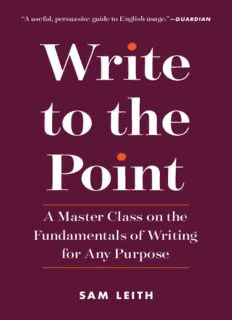
Write to the Point: A Master Class on the Fundamentals of Writing for Any Purpose PDF
Preview Write to the Point: A Master Class on the Fundamentals of Writing for Any Purpose
“A useful, persuasive guide to English usage.” —GUARDIAN A Master Class on the Fundamentals of Writing for Any Purpose S A M L E I T H Also by sAm leith Nonfiction Words Like Loaded Pistols: Rhetoric from Aristotle to Obama Dead Pets: Eat Them, Stuff Them, Love Them Sod’s Law: Why Life Always Lands Butter Side Down Fiction The Coincidence Engine A Master Class on the Fundamentals of Writing for Any Purpose S A M L E I T H NEW YORK Write to the Point: A Master Class on the Fundamentals of Writing for Any Purpose Copyright © 2017, 2018 by Sam Leith Originally published in the UK by Profile Books Ltd. in 2017. First published in North America by The Experiment, LLC, in 2018. All rights reserved. Except for brief passages quoted in newspaper, magazine, radio, television, or online reviews, no portion of this book may be reproduced, distributed, or transmitted in any form or by any means, electronic or mechanical, including photocopying, recording, or information storage or retrieval system, without the prior written permission of the publisher. The Experiment, LLC 220 East 23rd Street, Suite 600 New York, NY 10010-4658 theexperimentpublishing.com Many of the designations used by manufacturers and sellers to distinguish their products are claimed as trademarks. Where those designations appear in this book and The Experiment was aware of a trademark claim, the designations have been capitalized. The Experiment’s books are available at special discounts when purchased in bulk for premi- ums and sales promotions as well as for fund-raising or educational use. For details, contact us at [email protected]. Library of Congress Cataloging-in-Publication Data Names: Leith, Sam, author. Title: Write to the point : a master class on the fundamentals of writing for any purpose / Sam Leith. Description: New York, NY : The Experiment, LLC, [2018] | Includes bibliographical references and index. Identifiers: LCCN 2017052670 (print) | LCCN 2017059369 (ebook) | ISBN 9781615194636 (ebook) | ISBN 9781615194629 (softcover) Subjects: LCSH: English language--Rhetoric--Handbooks, manuals, etc. | Rhetoric--Handbooks, manuals, etc. | English language--Style--Handbooks, manuals, etc. | English language--Errors in usage--Handbooks, manuals, etc. | Composition (Language arts) Classification: LCC PE1408 (ebook) | LCC PE1408 .L4113 2018 (print) | DDC 808/.042—dc23 LC record available at https://lccn.loc.gov/2017052670 ISBN 978-1-61519-462-9 Ebook ISBN 978-1-61519-463-6 Cover and text design by Sarah Smith Manufactured in the United States of America First printing August 2018 10 9 8 7 6 5 4 3 2 1 For David Miller Contents 1. Surviving the Language Wars .........................1 2. The Big Picture ............................................10 You Talkin’ to Me? Speaking, Reading, and Writing ........10 Audience Awareness, or, Baiting the Hook ..................21 Plain and Simple ............................................ 26 Hitting the Right Note .......................................31 Abstract Versus Concrete ................................... 36 3. Nuts and Bolts ............................................40 Nouns and Pronouns ........................................40 Adjectives and Adverbs ..................................... 52 Verbs ......................................................... 58 Building Sentences .......................................... 68 Paragraphs, Sections, and Chapters ........................ 78 4. Punctuation and Symbols ..............................81 The Period ................................................... 83 The Question Mark .......................................... 83 The Exclamation Point ...................................... 85 The Ellipsis .................................................. 88 The Comma ................................................. 89 The Colon ................................................... 93 The Semicolon .............................................. 94 The Dash .................................................... 96 The Hyphen ................................................. 98 The Apostrophe ............................................102 Brackets and Their Friends ................................ 105 Quotation Marks ........................................... 112 The Slash ................................................... 119 Bullet Points ................................................120 The Hashtag ................................................120 The Ampersand ............................................ 121 The Smiley and Other Emoticons ......................... 121 5. Sentence Surgery: The Writer as Editor ..........124 Pomposo Furioso ...........................................128 The Academic Repeater .....................................131 The Confuser ...............................................133 The Monster ................................................136 The Interrupter .............................................141 6. Bells and Whistles: Bringing Things to Life ......144 Cadence .....................................................151 Using the Figures ...........................................161 7. Perils and Pitfalls ........................................171 Contested Usages ...........................................171 Red Rag Words ............................................. 187 Wrong Notes ............................................... 195 8. Out into the World .....................................199 Long-Form Structure ......................................199 Letters ...................................................... 211 Writing for the Screen .....................................225 Layout and Presentation ...................................242 Forms of Address ...........................................247 Acknowledgments ..........................................253 Index ........................................................255 About the Author. . . . . . . . . . . . . . . . . . . . . . . . . . . . . . . . . . . . . . . . . . . .264 1 Surviving the Language Wars M ost public discussion of how language is used—and certainly the most vociferous public discussion—is concerned with mistakes. Should that be a capital letter? Is it “different from” or “different than”? Where should that comma go—inside the quo- tation marks or outside them? On questions such as these, we’re encouraged to think, rests the difference between civilization and barbarism. These arguments have been characterized as “language wars”— and they can look like that. The sound! The fury! To one side, the Armies of Correctness mass behind fortifications made not of sandbags but of secondhand copies of Fowler’s Modern English Usage, Gwynne’s Grammar, and Strunk and White’s Elements of Style. Here’s Lynne “Deadeye” Truss, of Eats, Shoots & Leaves fame, her sniper rifle loaded with apostrophes, taking potshots at mispunctuated grocery advertisements; and there’s the William Safire platoon, preparing a shock-n-awe offensive involving the word “decimate,” which they hope will reduce the enemy forces by a tenth. On the other side, equally well dug in, are the Descriptivist Irregulars: a curious fighting force in which hippy-dippy school- teachers battle shoulder-to-shoulder with austere academic lin- guists. There are a lot of cardigans. Someone has just pulled the pin and lobbed a split infinitive over the barricades. Now they’re
Description: